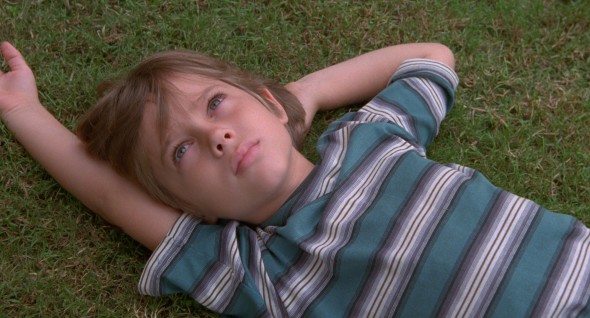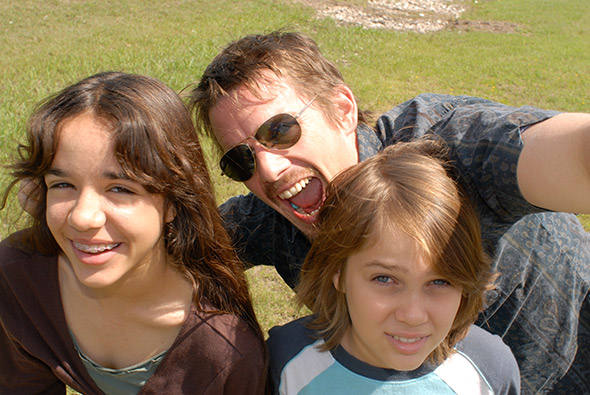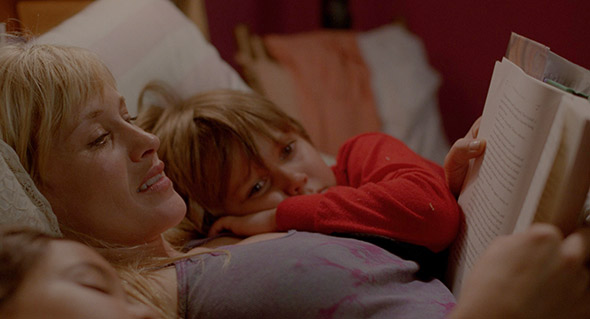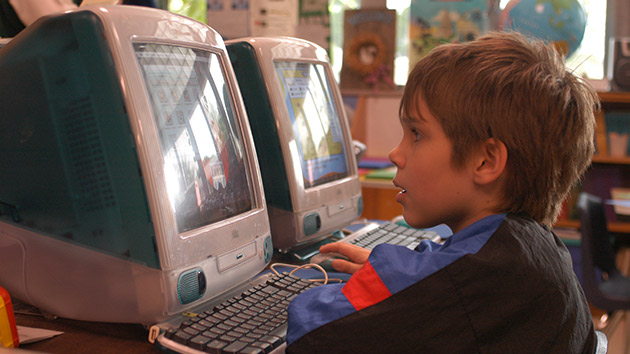First Assistant Editor Mike Saenz on Dealing with a Legacy Film-to-DVCAM 29.97 FPS Workflow in 2014
Shot a few days at a time in once-a-year installments from 2002 to 2013, director Richard Linklater's Boyhood, currently in release through IFC films, has an intimate scope that sets it apart. Because Linklater assembled a core group of actors who were willing to stay with the project for the duration, you watch the film's cast age dramatically over the course of its 165-minute running time, a real-life special effect that's more riveting than any number of CG shots or prosthetic make-up jobs. Like the actors, the project itself was aging rapidly behind the scenes, as breakthroughs in digital imaging technology quickly made the film's DVCAM-based workflow obsolete. Mike Saenz, first assistant editor on the film, talked to StudioDaily about the special challenge of uniting 12 years' worth of filmmaking in a single finishing workflow.
Image, top: Mason (Ellar Coltrane), age 7, in Richard Linklater’s Boyhood. All photos courtesy of Matt Lankes.

Mason (Ellar Coltrane), age 6.
StudioDaily: It sounds like you really had to build a bridge in the cutting room between footage that dated back as long as 12 years and a modern post-production workflow.
Mike Saenz: I came on about four years ago. At the beginning, this was a very indie project. Normally when Rick gets a movie into production, we rent an Avid and a Unity system and go about it in all the proper, comfortable ways. But this was a side project most of the time, and at its beginning, the editorial system was a consumer-grade Apple computer with Final Cut Pro. The dailies were transferred from 35mm to DVCAM and then ingested into Final Cut. That meant we were cutting in video — in 29.97. That was the best system you could afford if you were really going to just buy it yourself and keep it in the back of your office. A few years into it, Boyhood moved to Avid for the stability. Eventually, because of Moore's Law, systems got more and more powerful. Consumers could afford systems that used to cost $40,000, but because we would have had to retransfer years worth of dailies in order to cut in HD at film speed, we stuck with the way we’d been doing it. We ended up very much behind current technology with our poor DV, 29.97 match-back project. And we found that, when we came to finishing, nobody was really adept at doing a match-back 35mm project any more.
So Boyhood remained on DVCAM at 29.97 through all these years?
That’s right. We kept the DVCAM 29.97 match-back workflow all the way through finishing. When I joined the project, I was thinking, "OK, I remember how to do this." We were going to do a match-back cutlist, and post would pull the lab rolls and line up the key numbers in some negative-cutting facility and we’d cut neg. Or they’d pull the shots and scan them for the DI. But it turned out that's not the way it's done anymore. We had to come up with a new plan at the last second.
How did you adapt?
Cinelicious handled post [scanning the original film elements based on the offline edit] and said, "OK, no problem. Give us an EDL." And I said, "Well, if I give you an EDL, how will you know which tape corresponds to what lab roll?" And they said, "Each tape is its own lab roll, right?" Well, a lab roll is 10 minutes and we've been getting 60-minute tapes for 12 years. So we had several lab rolls per tape. And they said, "Oh. Nobody works with tapes any more. Things are digitized in one file per lab roll and that's your 'tape number.' You guys have more than one lab roll per tape?" “Um…yeah, we had several.”
So I had to find a way to translate our cutlist into an EDL so they could look up which lab rolls to physically pull. [Film editor] Sandra [Adair] and I were thinking, "Oh my god, how are they ever going to do this?" But Paul Korver and the rest of the guys at Cinelicious were very chill. They said, "Don't worry. If we do it this way it'll be no problem."
What I had to do was go through all 12 years of dailies in the Avid and for every lab roll, I would find the tape and timecode, starting at the hole punch, and then we would give Cinelicious an EDL. They would see tape number and timecode and, using that, find out which lab roll to pull, punch in the timecode start at the hole punch, and then pull the shot based on the EDL. Some of our telecine didn't have hole punches. Little mistakes like that are always being made. I would send a screen grab of the scene on a :00 timecode number so that they could match it by eye, punch in the timecode, and then go by the EDL.
Some of that info was on the report that comes in the lab roll box and some of it wasn't—not that I could look any of that up anyway, since the film boxes were all in L.A. and we were cutting in Austin.
So it was fairly straightforward once you figured out what the process was actually going to be?
We locked reels intermittently, and as we locked reels we would send Cinelicious new EDLs and the timecode would match and the shots would match the shots we wanted pulled. Then we would send the EDL to Parke Gregg at [Austin post facility] Stuck On On, who handled our DI.
Stuck On On conformed the 2.5K scans to our offline picture. In the end, Parke had to make the final tweaks to make sure everything in our new 23.97 fps project matched our offline 29.97 project as perfectly as it could.

Samantha (Lorelei Linklater), Mason Sr. (Ethan Hawke), and Mason (Ellar Coltrane), age 9.
It sounds like the whole project was an interesting and unique challenge.
Whenever you tell people you're shooting a movie over 12 years, the first thing they think of is what happens if one of your actors dies. That's the first question. What people don't think about is, OK, let's pretend you're shooting a movie with a 30-day shoot, and every few days you turn over 80 percent of your crew. That lack of crew continuity means the institutional memory of a project gets corrupted. Very few people stay on from year to year throughout the whole process.
For instance, we discovered that we had maybe two framing charts from the whole 12-year period, and what we were seeing in the Avid didn't necessarily match the scans that we got back. I pulled a framing chart and sent it to Cinelicious for their reference, but there's a lot of wiggle room when you're scanning a 35mm negative that was shot for 1.85. So we decided that, instead of scanning at 2K, we wanted to scan the entire Academy ratio at 2.5K — actually, they scanned at 4K and downsampled to 2.5K — so Parke had some wiggle room to reposition the frame without losing resolution.
I assume Linklater supervised all of those decisions.
Eventually he would supervise, but Sandra Adair was, as usual, very hands-on creatively in the finishing process. She attends rough mixes and final mixes and color-correction spotting sessions and so forth. She really likes to make sure that what we've been working with in the Avid is what we eventually see on screen, and Rick trusts her to shepherd that process until he comes in to direct the final and sign off. I may be biased, as a member of the editorial department, but I think everyone down the line knows that she speaks for Rick and that he trusts her completely.
She's been working with him since Dazed and Confused in 1993.
The only things he's done that she didn't cut were Slacker and Up to Speed, his Hulu series with Speed Levitch.
How did you connect with Linklater?
I'm from Austin, but I was cutting indie features in L.A. At one point I looked around and said, "I could be doing this at home. Richard Linklater does it. Austin has a great indie film community. I should just move back." I was trying to get my own film off the ground, which was a Texas film, so I thought it would be a good move. I had worked in L.A. for most of the 2000s and when I moved back to Austin I thought it would be great if I could be Richard Linklater's assistant editor. So I did a little turn in reality TV, but I was trying to network the whole time. I sent Sandra a cold email saying, "Hey, how's it going. And if you ever need any help, here's my resume." And she actually responded to say, "Thank you." Several months went by, and I asked if she could meet me for coffee, just as an introduction. And she said, "Sure," but it never happened. We'd play email tag every couple of months. And finally, her assistant on Bernie had to leave for another project.
She sent me an email one day and said, "Are you available and interested in working on Bernie? Can you swing by the office today for a meeting?" And when you get that email, the answer to that question is yes. It ended up working out. I took over for David Rosenblatt on Bernie and I've been with them ever since. I’m generally an editor. Aside from a few weeks at a motion-graphics company in 2002, I’ve never assisted for anybody but Sandra. But I thought it would be a good move to step back and assist for her on Rick’s films. And they’ve both been great.
It was a good move to contact her.
Now that I have a better understanding of the environment in the office, I'm shocked she ever committed to meet some stranger for coffee in the first place. She's very busy. But she's also very good at fostering relationships and trying to help people who are breaking in. And Sandra was unavailable to cut Up to Speed, so I was in a good position to take that project as an editor. Rick is a very collaborative and trusting director. I'm not surprised that so many of his crew have been with him as long as they have. You can see it in his casting choices, too.
It's interesting that so many people hear stories about what a great collaborative filmmaker he is, and then they look at the really loose, natural quality of the performances he gets and assume that means that his films are improvised. I notice that he's been making a point lately, in interviews, of explaining that the films are not improvised.
It takes a lot of work and preparation to look so organic and unscripted. A lot of that is to Sandra's credit. Rick is a minimalist in many ways. He doesn't like to have a lot of artifice in post-production. A lot of what Sandra looks for is the most natural performance, and we don't over-manicure what you see on screen.
On Boyhood, it's notable that not only did you have to compile footage that was shot over a 12-year period, but that the 12-year period of the shoot was probably the fastest moving, technologically, of any period in film history since the dawn of sound.
When anyone nowadays can buy a system that can cut a frame-accurate, 24-frame project in high definition, it's very difficult to explain to people why they're watching a DV 29.97 offline cut that is only accurate to plus or minus one frame once you get it conformed. Now you could cut broadcast quality footage on your laptop.
I remember when the high-definition editorial codecs first showed up, like DNxHD, and it was such a big deal for editors to finally start looking at high-quality pictures in the cutting room.
When we started to conform [Boyhood] we screened it for the first time in a high-definition format, and much of the movie was out of focus. That's not the kind of thing you can see with DV compression at 720×480, but it is the kind of thing that you see on a huge screen at nearly 2K. We did have to go and replace some stuff, and eventually we found the best footage. But for a while, everybody — including VFX and music — was getting offline stuff to do bids and preliminary work that was not going to be frame-accurate and was interlaced at 29.97. It was hard to explain to people, why, in 2013, you couldn't give them a high-resolution offline proxy to work with.
It must be exciting to be involved with a project that’s getting so much attention — even from people who wouldn't necessarily be interested in a Linklater film, or an "arthouse" movie, who are suddenly fascinated when they hear the story about how it was made over 12 years.
I think Rick put his finger on it. He said something to Ellar Coltrane. Ellar was getting older and it was becoming clear to him what kind of movie this was and that it was going to be a big deal. Rick wanted to lower his expectations, so he said, "Ellar, what is this movie about? In one sentence?" And Ellar couldn't put it into one sentence. And Rick said, "That's why no one is ever going to see this movie." [Laughs.] But at the time, he didn’t realize the actual process itself was going to be the one-sentence pitch that made it so interesting to people.

Crafts: Editing
Sections: Technology
Topics: Q&A dvcam long-term filmmaking mike saenz richard linklater sandra adair
Did you enjoy this article? Sign up to receive the StudioDaily Fix eletter containing the latest stories, including news, videos, interviews, reviews and more.











I am in the industry, but I come from the VO part; tech confounds me. Knowing how much has changed over the last half of my career – when this film was shot – it is fascinating to know the backstory. However, the result of all this labor is one of the best films I have ever seen. Congratulations to all who made it happen. (And if anyone reading this hasn’t seen it yet, find it and see it; I can almost guarantee (1) you’ve never seen anything quite like it and (2) you’ll be watching a great movie.